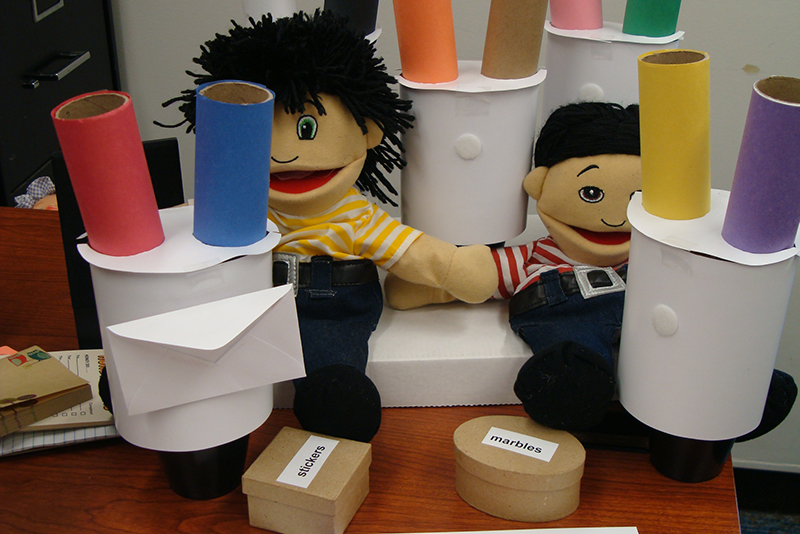Want Children to Listen? Write It Down
BU research finds early readers trust written over oral instructions

The next time you’re dreading a long car ride with young children, consider trying this experiment to get them to behave. For the first leg of the trip, give your kids oral instructions like “No screaming” and “No repeat requests for Frozen songs.” For the return trip, write down the same instructions and have your children read them before you leave.
Which method was more effective in maintaining your sanity? Kathleen Corriveau would wager the second one. The assistant professor in human development at Boston University’s School of Education has found that early readers, specifically three- to six-year-olds, trust written over oral instructions to guide their actions. She and three coauthors published their findings in May 2014 in the British Journal of Developmental Psychology.
It’s an interesting development, considering “most of what children read at this age is fiction,” says Corriveau. Her 2012 Peter Paul Professorship, sponsored by entrepreneur Peter Paul (Questrom’71) to aid young faculty in their careers, helped fund the research. “What we think is going on is they must be observing the link between adults around them modifying their actions based on text.” For example, children see adults reading recipes to decide what to put in a cake, or reading street signs to determine in which direction to turn. Corriveau says another possible explanation is that children “prefer consensus information over a single informant” who might have biases or make mistakes. Text might be seen as a neutral authoritative source.
Corriveau and her colleagues arrived at these conclusions after conducting a series of studies in Boston with hundreds of children who visited the Museum of Science’s Living Laboratory from 2011 to early 2014. Each child was asked to play a “tubes game,” which used two tubes of different colors that drained into an opaque basin over a cup. Children were told that one of the tubes was blocked, the other was open, and that the goal was to get a marble into the cup.
To guide the children’s choices, Corriveau recruited the help of two puppets: Lenny and Benny. One puppet gave oral instructions about which color tube to choose, such as, “I say blue. Choose the blue one,” while the other puppet read a clue from a slip of paper: “This says red. Choose the red one.” Corriveau says that “at this age, the ways that children talk to puppets and the ways that they talk to adults are similar.”

In the first study, the children listened to Lenny’s and Benny’s written or oral advice, chose a tube, and dropped their marble down it. Corriveau’s team cycled the children through four different tube pairs. The fifth time, the team brought out another puppet who asked the child for help choosing a tube. The point, according to the journal article, “was to probe whether children would articulate the rationale for their own choices.” Finally, to assess reading ability, researchers asked the children to match a colored circle with its corresponding written color word. Corriveau’s team found that children with basic reading skills preferred written to oral instructions, while children with little or no reading ability chose the tubes at random.
In the second study, Corriveau’s team tested whether extra evidence was biasing early readers toward text. After all, there was a puppet equipped with written clues in each game vying against another puppet voicing his own opinion. To test their hypothesis, they introduced a girl puppet who whispered advice to the puppet giving oral cues. They found the same results.
In the final study, Lenny and Benny each referred to an envelope to provide their clues. One contained a color word, such as “red,” while the other contained a colored circle, such as a red circle. Each puppet read the clue and showed it to the child, who then chose a tube. Again, early readers preferred the text clues, but pre-readers most often preferred the color shape clues. Corriveau’s team was intrigued because the children without strong reading skills finally showed a bias toward a particular type of clue. Since they could decode the color shapes, these children let the clue guide their actions—just as early readers did when faced with text clues. In each case, the children trusted most the clues they could interpret themselves.
All of this got Corriveau thinking about the power of the written word on young minds. “Where I really want to take this work is thinking about how children trust online sources of information, which I think is relatively powerful in our current media-driven society,” she says. Children are increasingly encouraged by parents and teachers to interact with educational apps and explore the internet for answers, yet “there are no good instructions on how to navigate online sources.” She would like to see more education, in schools and at home, regarding how to assess the credibility of written sources.
Meanwhile, parents might be able to exploit the amount of trust children place in text. Corriveau says she uses her newfound knowledge on her own three small children, who get extra sneaky around bedtime. She devised and wrote down a set of simple, straightforward sleep rules for her kids to read. “‘1. Stay in bed. 2. Be quiet. 3. Close your eyes. 4. Go to sleep,’” Corriveau says. “We find that they’re very effective for modifying behavior.”
Comments & Discussion
Boston University moderates comments to facilitate an informed, substantive, civil conversation. Abusive, profane, self-promotional, misleading, incoherent or off-topic comments will be rejected. Moderators are staffed during regular business hours (EST) and can only accept comments written in English. Statistics or facts must include a citation or a link to the citation.